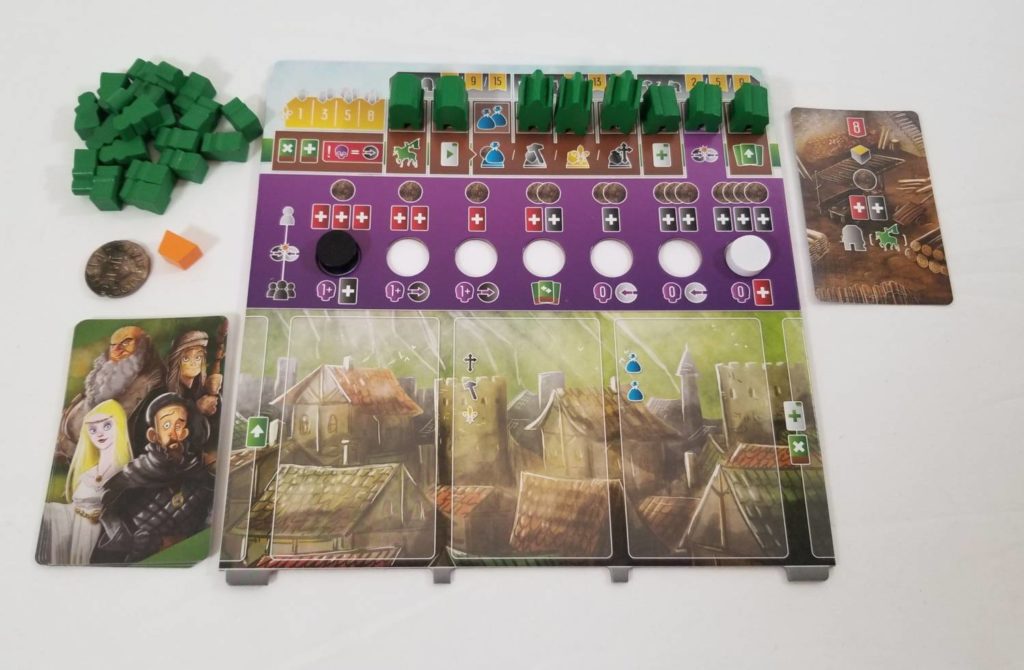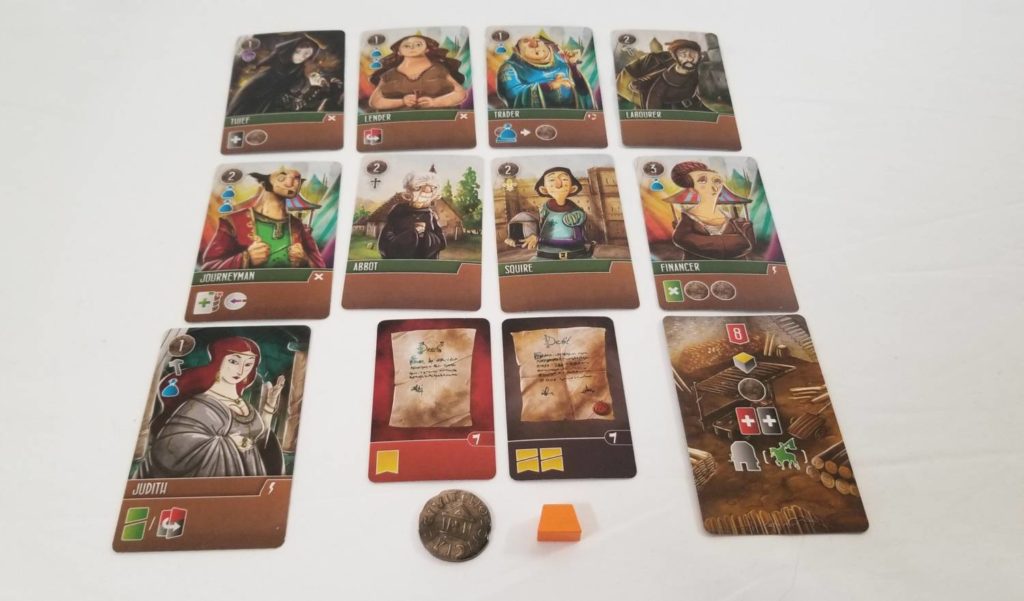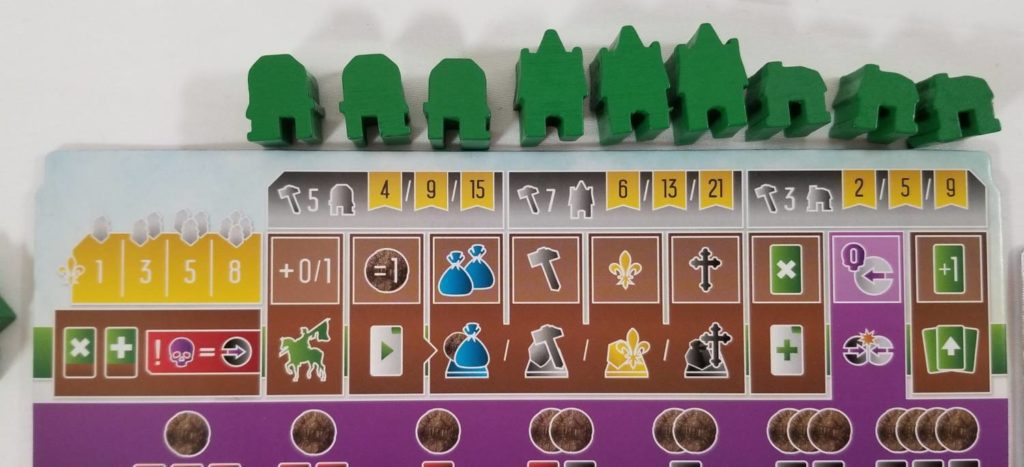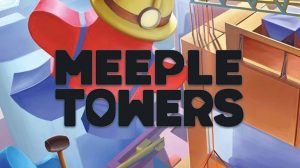Taking place a little less than a century after its predecessor, Paladins of the West Kingdom, Garphill Games’s Viscounts of the West Kingdom plops its players into a turbulent time of upheaval. The populace has spoken, and the general consensus is that enough is enough. Monarchy is on its way out and democracy is on its way in. As viscounts, the players must find a way to straddle the line between loyalty to the king and service to the people. For, should the monarchy survive, it wouldn’t do good to anger the sovereign. But, should it fail, there will be power to be had and it’s best to position yourself to capitalize on that power vacuum should it ever come to pass.
Viscounts is governed by a rondel-based action selection mechanism. Each turn, players add a card from their hands to their tableaux. Each card features iconography which ties into the game’s various actions. The card played determines how many spaces their titular viscount pawn can move around the board. Where the viscount ends its movement determines which actions the player can perform. After performing the chosen action, the player will have the option of paying money to add a Townsfolk card to their deck of cards, thus strengthening it for future turns. So, there’s also an element of deck building involved.
The object of the game is to score the most victory points, and there are many paths the players can follow to achieve this goal: building things, researching things, obtaining cards that reward them, and there’s even an element of area control that takes place in the center of the board that rewards players for how well they do. When the game ends after one of the end conditions are met, the players tally up their points to determine the winner.
Of course, this is just a high-level overview of the game. If you think you’ve heard enough and just want to know what I think, feel free to skip ahead to the Thoughts section. Otherwise, read on as we learn how to play Viscounts of the West Kingdom.
Setup
A game of Viscounts of the West Kingdom is set up thusly:

First, the segments of the mainboard are arranged to create an interlocked ring with a circle in the middle. The plastic castle piece is placed into this vacancy in order to lock the board segments into place. Then, each of the marked spaces is populated with face up piles of Neutral Townsfolk cards. The Manuscript tiles are arranged according to the game setup rules and placed face up into their marked positions.
Then the Debt and Deed card piles are created with the appropriate end-game card—Poverty and Prosperity, respectively—slotted into each at a certain depth depending on the number of players.

Next, each player chooses a color and receives the pieces and the Starting Townsfolk card deck of their chosen color, a player board, a Corruption marker, and a Virtue marker. The Corruption and Virtue markers are placed into their start locations at either end of the Corruption/Virtue track on the player board. Then, a number of Hero Townsfolk cards are dealt face up to the table, each paired with a randomly dealt Player card. A starting player is determined by some means. Then, in reverse turn order, players will draft one of these pairings. Their chosen Hero Townsfolk card is added to their deck. The Player card dictates what the players begin the game with—typically some collection of resources, money, Debt/Deed cards, and buildings. These cards also dictate in which sections of the main board the players’ Viscount pawns begin.

Once all that is completed, each player draws three cards as their opening hand and you’re ready to begin.
On Your Turn
Each of your turns is divided into several distinct steps. In case you forget them, there’s a convenient aid printed at the top of each Player board that depicts the steps from left to right.

First, if there is a card in the far right space of your card row, it “falls off” (gets added to your discard pile), which may cause a “falls off” action to trigger based on the card. Any remaining cards on the row slide one space to the right. Then, you’ll play one of the three cards from your hand into the leftmost spot. If the played card has an immediate effect, it is resolved as soon as the card is played. If the Townsfolk card played is a criminal (has a purple skull icon on it) the player gains corruption (move the Corruption token one space to the right) for every purple skull in their display.

Then the player moves their Viscount pawn an amount of spaces equal to or lesser than (but always at least one space) the number printed on the card that was just played. Viscounts move along the board in a clockwise direction, following the arrows printed on the board. For every silver a player pays, they may extend the Viscount’s distance by one.
The player’s Viscount will end up next to a pile of Townsfolk cards. The player has the option to dismiss the topmost card (remove it from the game) by paying silver equal to its cost. Then they’ll perform one of the actions, of which there are four. I’ll go into more detail about these later.
After performing the action, the player will have the opportunity to pay silver to hire the Townsfolk card from the top of the stack. Then, if their Corruption and Virtue markers have collided, they must resolve the collision, earning some combination of silver, Deeds, and/or Debts. Deeds are worth 1VP each (3VP if they are ever flipped over by an effect) at the end of the game. Debts are worth -2VP (or 1 free resource, if flipped). This collision also affects the other players in a lesser manner based on how corrupt or virtuous they are at the time.
Lastly, the player draws up to their hand size of three cards and it becomes the next player’s turn.
The Actions
Each action is affiliated with a specific icon. The more of the affiliated icon present on the player’s board when the action is performed, the more powerful the action will be. Some actions can be further boosted by spending specific resources as if they were the affiliated icons and/or by dismissing Townsfolk from the board to gain temporary access to the icons they provide. Furthermore, the purple skull icons are ‘wild’ icons and can act as stand-ins for anything else.
The Main board is divided into an outer ring and an inner ring. Some actions are only available on the outer ring while others are only available on the inner ring. The actions, their affiliated icons, the ring on which they reside, what they can be supplemented with, and what they accomplish are as follows (I’ll try to keep it brief):
Outer ring
Trade (blue moneybags): silver – Use Merchant icons to perform exchanges for whatever’s shown on the Viscount’s space at whatever the listed rate is.
Construct a Building (silver hammers): stone – Use Builder icons to construct one of the buildings from your player board into one of the empty areas bordering where your Viscount wound up. Removing buildings uncovers icons on the Player board which provide permanent benefits. Placing buildings on the Main board earns the player bonuses for covering up, or surrounding, the icons printed there.
Inner Ring
Place Worker (gold fleur de lis): gold – The number of icons determines how many workers you can place. The workers are placed into the first ring of the castle. Each ring of the castle, with the exception of the center, is divided into five sectors.
After placing workers, a check is performed to determine whether you have three or more workers in that sector. If you do, one worker progresses into the second ring (earning you an immediate bonus), one is moved into the sector to the right, and another is moved into the sector to the left. Then another check is performed on each of those sectors to see if they trigger any movement, rinse and repeat (including the sectors in the second ring), until nothing else moves.
Then, each sector (minus the center) is examined again to determine if any holds three or more workers, regardless of color. If they do, then each of these sectors has a worker bumped off of it, (active player’s choice). Bumped workers earn their controllers a bonus of some sort, so getting bumped isn’t necessarily a bad thing.
Reaching the center of the castle rewards an immediate bonus of a resource of your choice. If adding a worker to the middle should cause you to have a majority of workers present there, you also gain the Castle Leader card, which is worth extra VP at the end of the game. It also gives you a bonus of one extra hand card for as long as it’s in your possession.
Transcribe a Manuscript (black cross): inkwells – Each Manuscript tile has a cost and a benefit it provides upon acquisition. Furthermore, each Manuscript tile has a bookmark shown on it of a certain color. Collecting sets of different colored bookmarks rewards varying amounts of VP at the end of the game. If a player is the first to transcribe three of a specific color, they collect the Cleric Bonus card for that color, which is worth points at the end of the game.
End Game and Scoring
Once either the Poverty or Prosperity card is revealed, the end game is triggered. The current round is finished, and players get one additional round. Then, final scores are tallied to determine the winner. Points come from a number of sources:
– Constructed buildings (based on how many of a specific kind were built)
– Workers in the castle (based on which ring they reside in)
– Transcribed manuscript sets
– Castle Leader and Cleric Bonus cards
– Unpaid debts (negative VP)
– Deed cards (based on their unflipped or flipped status)
– If revealed, Poverty/Prosperity cards (based on who has the most/second most/third most flipped Deed cards or flipped Debt cards, respectively)
Thoughts
I’m a big fan of Garphill Games and I am a huge fan of the West Kingdom trilogy in particular. Architects of the West Kingdom came out swinging, a statement of a game that told the world that Garphill was getting serious. And then they backed that up even further with Paladins of the West Kingdom, one of the finest games I have ever played. This change in course came about, no doubt, with Shem Phillips teaming up with Sam Macdonald. Like Penn meeting Teller, their team up has created magic. Viscounts proves they haven’t lost their spark.
One of my favorite things about Garphill’s “cardinal direction” series of games—x of the North Sea, y of the West Kingdom, z of the South Tigris—is that, with the exception of Raiders of the North Sea, not a single one of them includes a score track. Whether intentional or unintentional, the net effect is that the players are free to play in the games’ sandboxes, exploring their various nooks and crannies, without having to worry about how far ahead or behind they are when it comes to the other players. This provides each game with moments of high anticipation when the winner is revealed at the end of the game, often with surprising results. This is just one of those things that Garphill Games does so well.
I also love the way that Phillips and Macdonald are able to blend tried and true mechanics together to create an experience that feels like something you’ve never encountered before. In Viscounts, the blend is especially potent, creating a sort of board game ouroboros. The deck building mechanic plays directly into the tableau building mechanic which effortlessly feeds the rondel mechanic which fuels the action selection mechanic which provides fodder for the deck building mechanic. The snake never stops eating its tail, and what a delicious tail it is!
I could wax ecstatic all day about the game’s constituent parts (not to mention The Mico’s fantastic artwork), but I won’t bore you with that. Instead, I want to talk about my favorite part of Viscounts, the castle. First off, that castle component is SUPER COOL. It is easily one of the neatest components in any board game ever. It’s got that wow factor about it, a table presence that can’t be denied.
Secondly, I love the way everything in the castle chains off of everything else. It feels good watching the workers you placed trigger a reaction. But, it’s especially fulfilling watching the workers you placed trigger a series of reactions from workers you’ve cleverly placed earlier in the game. It’s a long set up with a beautiful pay off.
In one game that I played, I’d managed to manipulate two of my workers into each of the second ring sectors. Then, on a later turn, I dropped three workers into the first ring and an amazing sequence of events ensued. That sector exploded into the sectors surrounding it, sending one worker into the second ring. That second ring sector exploded, catapulting a worker into the castle center, and also causing each of the second ring’s other 4 sectors to explode. When the dust settled, I had five workers in the castle center that hadn’t been there before, a small pile of resources I hadn’t had when my turn began, and the Castle bonus card. I’d even managed to eject several of my opponents’ workers from the castle in the process! It was a glorious feeling watching it unfold.
Viscounts is a game chock full of moments like those. And that’s why I have no problem recommending it. I absolutely love it.












Add Comment